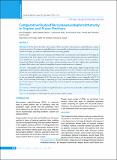Please use this identifier to cite or link to this item:
https://hdl.handle.net/20.500.14356/1076| Title: | Comparative Study of Percutaneous Nephrolithotomy in Supine and Prone Positions |
| Authors: | Chapagain, Anup Basnet, Robin Bahadur Shah, Chitaranjan Shah, Arvind Kumar Shrestha, Parash Mani Shrestha, Anil |
| Citation: | ChapagainA., BasnetR. B., ShahC., ShahA. K., ShresthaP. M., & ShresthaA. (2021). Comparative Study of Percutaneous Nephrolithotomy in Supine and Prone Positions. Journal of Nepal Health Research Council, 19(1), 154-157. https://doi.org/10.33314/jnhrc.v19i1.3346 |
| Issue Date: | 2021 |
| Publisher: | Nepal Health Research Council |
| Article Type: | Original Article |
| Keywords: | percutaneous nephrolithotomy prone position supine position |
| Series/Report no.: | Jan-March, 2021;3346 |
| Abstract: | Abstract Background: The aim of the study is the compare efficacy and safety of percutaneous nephrolithotomy in supine and prone positions. Percutaneous nephrolithotomy is conventionally performed in prone position but in recent years numbers of supine percutaneous nephrolithotomies is increasing globally. Methods: The hospital based cross-sectional observational study was conducted in the Department of Urology, Bir Hospital from July 2018 to January 2020. A total of 81 consecutive patients undergoing percutaneous nephrolithotomy were divided into two groups, with 38 patients in Supine (Group 1) and 43 patients in Prone (Group 2) positions, respectively. Patient’s demographics, access time, operative duration, stone free rate, radiation dose and duration, irrigation fluid volume, post-operative hemoglobin drop and complications were compared. Results: Demographic and stone characteristics were comparable in both groups. Supine Group (Group 1) had significantly shorter operative duration than Prone Group (Group 2), 44.63 ± 12.44minsvs 53.02 ±12.67mins (p< 0.04). The mean radiation duration was 99.11 ± 61.17secs in Group 1 and 108.40 ± 51.65 secs in Group 2 (p=0.46), respectively. Although the mean radiation dose was lower in Group 1 (375.1µGym2) than in Group 2 (465.7 µGym2), it was not statistically significant(p=0.24). The stone free rate at 1 month duration were comparable with 92.1% and 93.02% in Group 1 and Group 2 respectively (p=0.16). Overall complication rates were similar in both groups (15.7% in Group 1 vs 16.2% in Group 2), respectively. None of the patients in both groups had complications higher than Clavien IIIa. Conclusions: PCNL in supine position has significantly shorter operative time with similar complications and stone free rates as compared to prone position. Keywords: percutaneous nephrolithotomy; prone position; supine position |
| Description: | Original Article |
| URI: | http://103.69.126.140:8080/handle/20.500.14356/1076 |
| ISSN: | Print ISSN: 1727-5482; Online ISSN: 1999-6217 |
| Appears in Collections: | Vol. 19 No. 1 (2021): Vol. 19 No. 1 Issue 50 Jan-Mar 2021 |
Files in This Item:
| File | Description | Size | Format | |
|---|---|---|---|---|
| 3346-Manuscript-21568-1-10-20210425.pdf | Fulltext Download | 211.71 kB | Adobe PDF |  View/Open |
Items in DSpace are protected by copyright, with all rights reserved, unless otherwise indicated.
